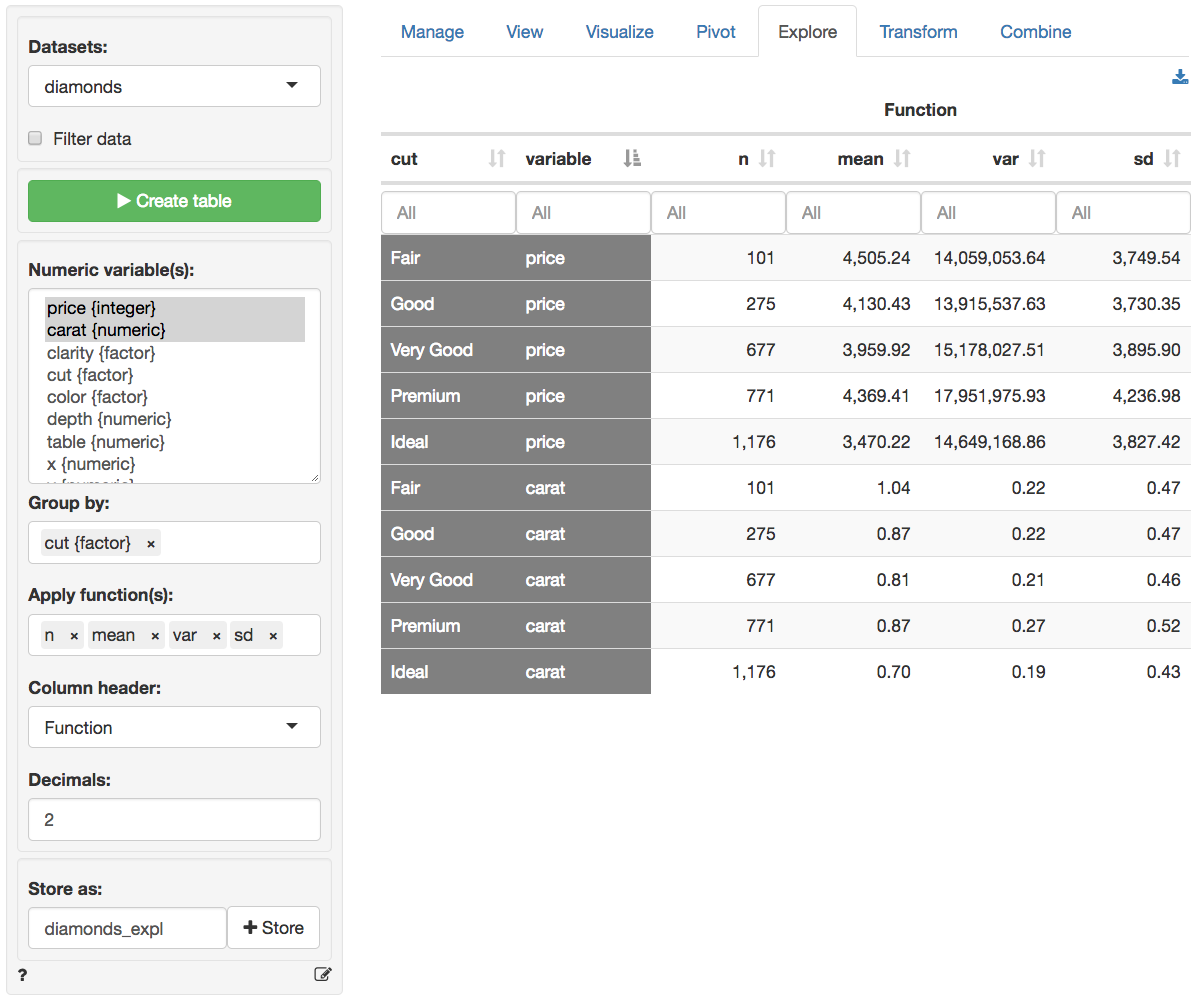> Summarize and explore your data
Generate summary statistics for one or more variables in your data. The most powerful feature in _Data > Explore_ is that you can easily describe the data _by_ one or more other variables. Where the _Data > Pivot_ tab works best for frequency tables and to summarize a single numeric variable, the _Data > Explore_ tab allows you to summarize multiple variables at the same time using various statistics.
For example, if we select `price` from the `diamonds` dataset and click the `Create table` button we can see the number of observations (n), the mean, the variance, etc. However, the mean price for each clarity level of the diamond can also be easily provided by choosing `clarity` as the `Group by` variable.
> Note that when a categorical variable (`factor`) is selected from the `Numeric variable(s)` dropdown menu it will be converted to a numeric variable if required for the selected function. If the factor levels are numeric these will be used in all calculations. Since the mean, standard deviation, etc. are not relevant for non-binary categorical variables, these will be converted to 0-1 (binary) variables where the first level is coded as 1 and all other levels as 0.
The created summary table can be stored in Radiant by clicking the `Store` button. This can be useful if you want to create plots of the summarized data in _Data > Visualize_. To download the table to _csv_ format click the download icon on the top-right.
You can select options from `Column header` dropdown to switch between different column headers. Select either `Function` (e.g., mean, median, etc), `Variable` (e.g., price, carat, etc), or the levels of the (first) `Group by` variable (e.g., Fair-Ideal).

## Functions
Below you will find a brief description of several functions available from the `Apply function(s)` dropdown menu. Most functions, however, will be self-explanatory.
* `n` calculates the number of observations, or rows, in the data or in a group if a `Group by` variable has been selected (`n` uses the `length` function in R)
* `n_distinct` calculates the number of distinct values
* `n_missing` calculates the number of missing values
* `cv` is the coefficient of variation (i.e., mean(x) / sd(x))
* `sd` and `var` calculate the sample standard deviation and variance for numeric data
* `me` calculates the margin of error for a numeric variable using a 95% confidence level
* `prop` calculates a proportion. For a variable with only values 0 or 1 this is equivalent to `mean`. For other numeric variables it captures the occurrence of the maximum value.
For a `factor` it captures the occurrence of the first level.
* `sdprop` and `varprop` calculate the sample standard deviation and variance for a proportion
* `meprop` calculates the margin of error for a proportion using a 95% confidence level
* `sdpop` and `varpop` calculate the population standard deviation and variance
### Filter data
Use the `Filter data` box to select (or omit) specific sets of rows from the data. See the helpfile for _Data > View_ for details.
### Report > Rmd
Add code to _Report > Rmd_ to (re)create the summary table by clicking the icon on the bottom left of your screen or by pressing `ALT-enter` on your keyboard.
### R-functions
For an overview of related R-functions used by Radiant to summarize and explore data see _Data > Explore_

